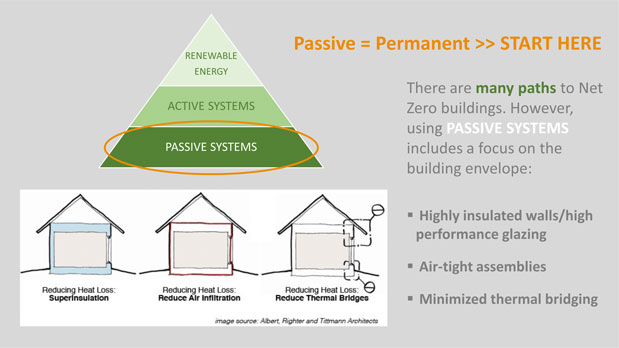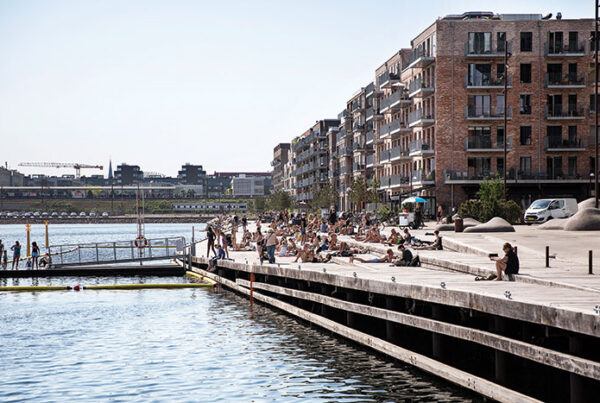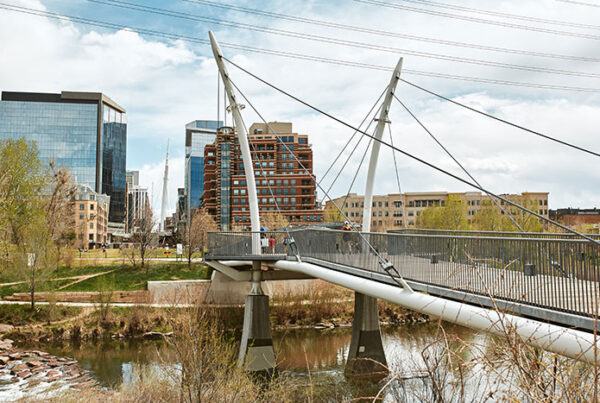An on-demand session at the 2021 ULI Virtual Spring Meeting covered five technologies helping make net-zero-energy buildings a possibility. Moderator Marta Schantz, senior vice president of the ULI Greenprint Center for Building Performance, said, “The future of real estate is clear: buildings have to get to net zero.”
A net-zero building is highly energy efficient and either produces the energy it needs from renewables on site like solar panels, or sources green energy off site. Five technologies, in particular, can work in concert to help buildings hit net zero while improving asset value and lowering costs, and they all can be implemented in existing buildings or new construction.
High-Performance Building Envelopes
Starting with the building envelope is essential. “Fifty percent of a building’s energy demand is attributable to heat loss through the envelope, and that’s what makes it so important to net zero,” said Heather Elliot, associate and building envelope specialist at Entuitive, a multisector engineering and design consultancy. By designing or retrofitting highly insulated and well-sealed envelopes, heat losses drop significantly (as does heat gain in warmer climates), improving occupant comfort and significantly reducing energy costs.

Above and below: Heather Elliott, associate and building envelope specialist at Entuitive, covers the key points behind high-performance building envelopes, an essential passive design strategy for net zero buildings.

Since they require no energy to run, high-performance envelopes are considered a “passive” strategy, which are free of operation costs and “tend to be more permanent, and they represent an investment across the building’s life cycle to help achieve net zero,” Elliot noted. Though passive design strategies have existed in vernacular architectures for thousands of years, the technology to analyze their performance is constantly evolving, and now has the capability to model multiple combinations of options that ensure highest cost-effectiveness.
Once the envelope has lowered the baseline of energy needed to heat and cool a building to this highly efficient level, heating, ventilation, and air-conditioning (HVAC) systems can be significantly downsized and efficient models can be selected, such as those based on air source heat pumps.
Air Source Heat Pumps
Air source heat pumps, or ASHPs, are “the HVAC solution to lead us to net zero,” said Doris Han, vice president of engineering products at BlocPower. A heating and cooling solution that can also provide domestic hot water, ASHPs are three to four times more efficient than typical boilers and work on entirely different principles. Rather than burning fossil fuels to generate energy, heat pumps use electricity to move energy from one place to another, and they can work well in mild or cold climates.
During cold weather, heat pumps use pressurized refrigerants to pull energy from the outside air and pump it indoors as heat. During hot weather, the flow of the refrigerant flips and the process reverses, transferring energy out of indoor air and cooling spaces down.

Above and below: Doris Han, vice president of engineering products at BlocPower, discusses the benefits of air source heat pump HVAC systems as an all-electric, efficient source of building heating and cooling.

Since they use electricity as an energy source and do not generate any carbon emissions on site, heat pumps are a key resource in the path toward net zero—and those that use electricity from renewable sources are entirely carbon free. They also are a common feature in all-electric buildings.
Market adoption is growing, with annual sales on track to reach $95 billion by 2023, Han notes. Heat pump retrofits are particularly suitable for buildings with aging HVAC systems, high utility bills or maintenance costs, and plans to conduct other major renovations. Some companies, including BlocPower, offer installations without a downpayment for eligible buildings, simplifying the process further.

Above and below, an example of a multifamily building that rented its roof space for provide solar power for nearby affordable housing, discussed by Victoria Stulgis, vice president of client operations at Black Bear Energy.

On-Site Solar
Solar panels, whose ability to convert solar energy to electric current is already familiar to most, play a huge role in helping buildings reach net zero by providing carbon-free energy. After high-performance envelopes and HVAC systems like heat pumps reduce building energy demand, on-site solar is much more likely to be able to meet the remaining energy need entirely, so that the building can reach net zero. “There are geographies today where . . . clients can absolutely power 100 percent of their operations with solar. It depends on the geography and whether they have enough host site [space for panels],” said Victoria Stulgis, vice president of client operations at Black Bear Energy.
Intensive energy-using buildings like data centers or buildings with less square footage for panels in proportion to energy use, like tall multifamily buildings, may not be able to produce 100 percent of their energy needs on site, but they can often make a big contribution toward those needs—or can lease available roof space for panels to a third party, increasing building income.
Shorter office buildings often sit in a sweet spot, with energy use low enough and roof space or parking lots ample enough to meet the building’s energy needs. In addition, the calculus for how much energy can be produced on site may soon shift as panels embedded in windows or attached to facades become more common and cost-effective, and panels themselves become more efficient.
Once buildings have exhausted the on-site capabilities for renewables like solar, they can turn to renewables from off-site sources to meet the remainder of their energy demand without burning fossil fuels, thereby reaching net zero.
Building Sensors and the Internet of Things
Building envelopes, heat pumps (among other mechanical systems), and renewables are three important technologies for reaching net zero (in addition to lighting, which is not covered here). The final two technologies covered in this on-demand session—building sensors and battery storage—work to make the process of hitting net zero more efficient or expand the benefits and cost-effectiveness of other technologies.

Above and below: Ben Dwyer, vice president of Siemens’ Digital Enterprise Business, speaks to the power of sensor technology at the 2021 ULI Spring Meeting.

Building sensors—small processing units that connect physical building components wirelessly to a cloud-based management system (the internet of things)—create what are known as smart buildings and enable the collection and analysis of an enormous amount of data points on how a building is being used, enabling adjustments that drive further efficiencies. “These are very small devices that are incredibly powerful and can bring incredible use cases to help realize net zero,” said Ben Dwyer, vice president of Siemens’ Digital Enterprise Business.
Sensors and smart buildings collect data from a wide variety of assets, allowing developers, owners, and occupants to monitor and apply insights derived in real time within buildings. Having sensors in place takes the guesswork out of managing building systems, and buildings can become responsive to their environment, adapting to changing conditions to maintain interior comfort.
Dwyer highlighted sensors’ ability to measure lighting levels, occupancy patterns within building spaces, power demand, and temperature controls, all of which can be adjusted through a building automation system to ensure that major energy uses like lighting, power supply, and heating/cooling are as efficient as possible. These “small but mighty” sensors help fine-tune building management at a highly granular level, and “enable even more efficient cost savings as it relates to energy,” Dwyer noted.
On-Site Battery Storage
“A lot of the technologies we’ve talked about today either generate electricity or reduce the total amount of electricity needed; battery storage doesn’t actually do either of these things, but it’s still integral to ensuring the grid can handle the intermittency of renewables in a net-zero future,” said Stulgis. Renewables like solar and wind are not as consistent in output as fossil fuels, meaning that battery storage is needed to absorb energy when production is high and discharge energy when production is low, helping ensure that energy is distributed evenly throughout the day and the energy grid remains reliable.
Batteries can help, in particular, with driving down high energy costs by supplying energy when peak demand is highest and energy is most expensive. Drawing from an on-site battery at these times “shaves off” electricity use at those peak times (a practice known as peak shaving) and ensures that the utility only sees and charges for use at lower-demand, lower-cost times.
Building owners should expect to see batteries becoming standard as solar production ramps up. In places like Hawaii, which generates huge amounts of solar energy, discharging back to the grid is prohibited and batteries are now required since it is unclear whether the grid can handle the extra input. As the use of renewables scales up, batteries will be essential supplements for creating a resilient, cost-effective energy supply.
The path to net-zero buildings may sound daunting, but these five technologies can help break it down: reduce building energy demand as much as possible, use sensors to optimize what cannot be eliminated, and turn to renewables to meet whatever demand remains through on-site and then off-site options, with batteries to make sure that the power is there when needed.



